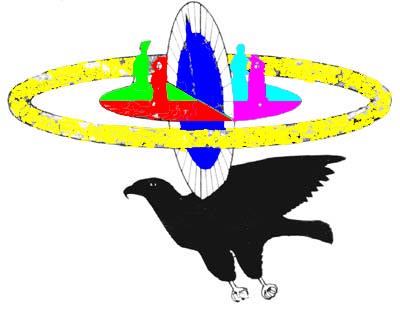
"... Wolfgang Pauli is ... famous for his formulation of the two-valuedness of the electron spin, for the exclusion principle [for fermions], and for his prediction of the neutrino. ... Both ... Pauli and the psychologist Carl Gustav Jung ... stressed the inseparability of the physical and the psychical ... According to Jung, three layers can be distinguished in the human psyche:
Jung considers the collective unconscious as "objective", prior to individual experience, and acting as a source of imagination and creative work. ... The archetypes belong to the contents of the collective unconscious. ... Pauli favoured the thesis that creative ideas are formed through a correspondence between the outer reality and archetypal images. ..." [from a 28 March 1999 message from "Barron Burrow" about The Hidden Side of Wolfgang Pauli: An Eminent Physicistís Extraordinary Encounter with Depth Psychology].
[From Carl Gustav Jung, by Frank McLynn (St. Martin's Press 1996), at page 497]: "... Jung loved elaborate diagrams ... preferably in quaternary form ... He and Pauli ... sometimes 'modelled' a seven-dimensional space-time. ...".
[ If Jung and Pauli had considered a 7-dimensional space, corresponding to the 7 imaginary octonions, they might have seen the 1+7 dimensional structure of the Cl(1,7) Clifford algebra on which the D4-D5-E6-E7-E8 VoDou Physics Model is based. ]
[From a psychovision web page]: "... C.G. Jung borrowed from a student of Paracelsus, Gerhard Dorn (Dorneus), who called it the unus mundus, the "Unified World". The energetic principle of this unus mundus was known as the world soul (anima mundi) ... in the natural philosophy of the Middle Ages. Synchronicity is based upon this medieval concept of the world soul and the unus mundus, that corresponds to Wolfgang Pauli's world of "background physics" ... connections between radioactivity and space-time on a psychophysical level ...
[ As Lev Tarasov says in The World is Built on Probability (Mir 1988): "... Let us take ... the example with neutron decay. ... There is no internal "clock" in a neutron. ... only a hundred per cent isolated particle can behave spontaneously. ... a particle is not isolated, it interacts with the world around it. ... The idea of the unity of the world and the universal interrelation of the phenomena in it acquires a special meaning on the level of the microcosm ... A vacuum in quantum mechanics is not a void but a space in which particles are randomly born and annihilated. The neutron interacts with them. ...". ]
... Wolfgang Pauli's ... Anima - in Jungian psychology the bridge to yet unknown creative ideas in the collective unconscious - manifests her conception of time with the assistance of "odd oscillation symbols", that belong to the same category of periodic symbols as "the light and dark stripes" and the "pendulum and the 'little men' ..." relate[d] to his so-called world-clock vision of 1934, which ... generated in Pauli a sensation of "sublime harmony" ... its content - understood on a psychophysical level - would have been the solution of the ... problem of Pauli's Anima. ... the relevant messages in Pauli's dreams are: "Beta radioactivity (antineutrino) and synchronicity are connected in a manner yet not understood" and "Behind the world of quantum physics another dimension is hidden" ... Bohm's idea of an implicate order behind quantum physics appears to be similar to what Wolfgang Pauli and C. G. Jung sought in their later years, the unified psychophysical or unified psychoid reality, the unus mundus ... except for one major difference. ... individual consciousness and the collective unconscious play no role in ...[Bohm's]... theory ...[while]... Pauli and Jung felt that individual consciousness is able to come into relation with this implicate order. ...
... Wolfgang Pauli was not able to find this solution. ... he was painfully conscious of the limits of his scientific creativity when he wrote to C.G. Jung in 1952 that the future challenge must include finding "that other, more comprehensive coniunctio" (union of opposites), that transcends the artificial separation of psyche and matter and the "smaller coniunctio" of quantum physics, namely Bohr's complementarity of particle and wave. ...".
An impression generated by artist W. Beyers-Brown based on accounts of Pauli's dream. The vision of the world clock ... originally published by C. G. Jung ...

The above image is taken from a Bill Stillwell January 2003 web image of a murder of crows.
Within each of the 4 colors (shown as red, green, cyan, and magenta) of the horizontal circle there are 4x8 = 32 vertical circle pointer positions times x 32/4 = 8 horizontal circle positions, for a total of 4 x 8 x 8 = 16 x 16 = 256 = 2^8 possible positions, corresponding to the 256 possibilities of IFA =VoDou divination and the 256 binary elements of the Cl(1,7) Clifford algebra of the D4-D5-E6-E7-E8 VoDou Physics Model, so that each of the 4 colors (shown as red, green, cyan, and magenta) contains one copy of the local neighborhood model of VoDou Physics. The 256 = 32x8 = 16 x 16 = 2^8 binary choices of Cl(1,7) form the more comprehensive coniunctio (union of opposites) for which Pauli was searching.
Each copy of the world clock contains a VoDou Physics model for each of 4 local neighborhoods, which can be considered as being neighbors located on 4 vertices of one of the 16 tetrahedral 3-dimensional faces
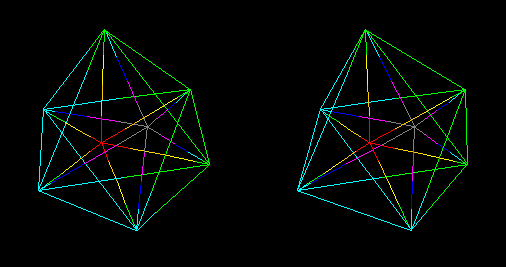
of a cross-polytope (hyper-octahedron) in 4-dimensional physical spacetime.
The dark (black hole) state of the dark/golden ring represents a ring singularity of a Kerr-Newman black hole of a Compton radius vortex model of elementary particles. The 4 children who carried the ring in its dark state represent the 4 dimensions of internal symmetry space which, together with the 4 little men of the 4 colors of the horizontal circle (representing 4-dimensional physical spacetime), represent the 8 dimensions of the Cl(1,7) Clifford algebra and high-energy spacetime. Each little man's pendulum measures the propagator phase of the particle at his vertex.
The golden (golden ratio) state of the dark/golden ring represents Hopf tori and Hopf-Clifford circles in a Hopf fibration of S3 related to Segal's conformal physic and cosmology. An exotic form of S3 is Poincare dodecahedral space S3#, which has icosahedral golden ratio symmetry.
The flight path of the black bird represents a world-line of the many-worlds, which by 26-dimensional closed bosonic string theory, expanded to its 27-dimensional M-theory and 28-dimensional F-theory, describes a mechanism underlying Bohm's implicate order that allows consciousness, through resonant connections, to influence the unfolding of the implicate order and therefore to influence fate.
Therefore,
and
many black birds acting together, as in a murder of crows, provide an accurate description of physics and psyche on larger scales.
"... Far from being the antithesis of creativity, constraints on thinking are what make creativity possible. ... Mozart is free to create things others cannot imagine, because he is bound by principles others cannot see. ...".
"... there ...[are]... only five perfect polyhedra -the cube
,
the tetrahedron
,
the octahedron
,
the icosahedron
, and
the dodecahedron
. [images from a Wikipedia web page]
Kepler described putting these one inside another as follows:
- The Earth's orbit is the measure of all things;
- circumscribe around it a dodecahedron, and the circle containing this will be Mars.
- Circumscribe around Mars a tetrahedron, and the circle containing this will be Jupiter.
- Circumscribe around Jupiter a cube, and the circle containing this will be Saturn.
- Now inscribe within the Earth an icosahedron, and
- the circle contained within it will be Venus.
- Inscribe within Venus an octahedron, and the circle contained within it will be Mercury.
You now have the reason for the number of planets. ...".
the simplex
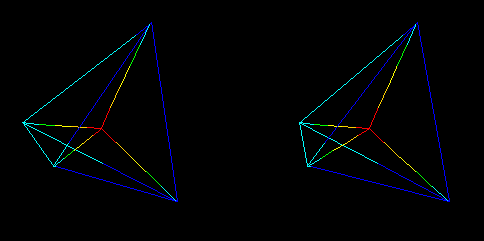 ;
;
the cross-polytope (hyper-octahedron)
 ;
;
the hypercube
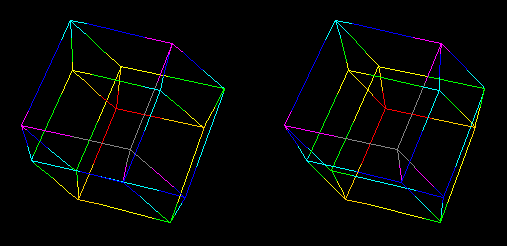 ;
;
the 24-cell (the "sixth" one that appears only in 4 dimensions, which corresponds in 3 dimensions to the cuboctahedron and its dual the rhombic dodecahedron, neither of which are technically "regular" polytopes) (It is the vertex figure of the integral quaternions, and is the only centrally symmetric self-dual regular polytope, and is the root vector polytope of the D4 Lie algebra and, when combined with its dual, forms the 48-vertex root vector polytope of the F4 Lie algebra. In the years 1980-1984, it and its dual formed the archetype/mandala/vision in my mind that motivated me to continue working on what has become my D4-D5-E6-E7-E8 VoDou Physics model, and showed me the basic structure that I needed to construct the model.)
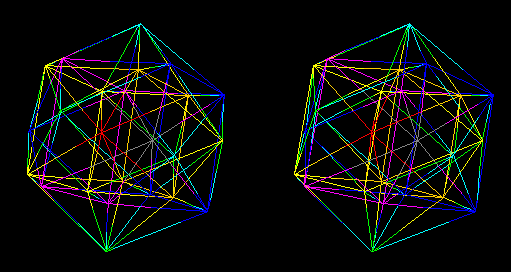 ;
;
the 120-cell
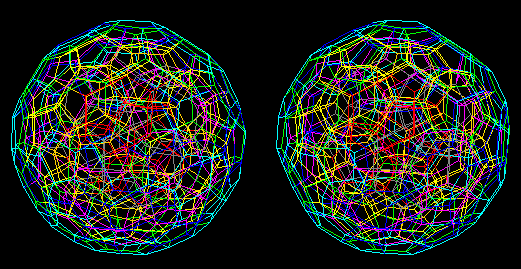 ;
and
;
andthe 600-cell
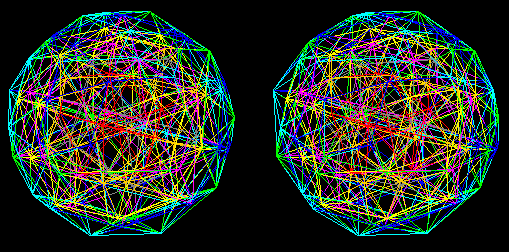 .
.In dimensions 5 and higher, there are only three regular polytopes: the simplex, the cross-polytope, and the hyper-cube.
The above comments pertain to real dimensionality. In complex dimensions two, three and four, there are interesting regular polytopes, as described by Coxeter in his book Regular Complex Polytopes (Cambridge, 2nd ed, 1991):
"... Kekule's discovery of the benzene-ring. ... He described it like this: I turned my chair to the fire and dozed. Again the atoms were gambolling before my eyes....[My mental eye] could distinguish larger structures, of manifold conformation; long rows, sometimes more closely fitted together; all twining and twisting in snakelike motion. But look! What was that? One of the snakes had seized hold of its own tail, and the form whirled mockingly before my eyes. As if by a flash of lightning I awoke ...".
"... In the case of Karl Alex Mueller ... a major motivation was ...[his]... feeling that the highly symmetrical crystal stucture that proved essential to the discovery of high-temperature superconductivity ...[in Perovskite-type Oxides]... had the affective power of a mandala ... Mueller later chose the Dharmaraja mandala ...... to illustrate an introspective essay on his sources of inspiration. ... Perovskites ... are a class of ceramics that have a particular atomic arrangement. In their ideal form perovskites, which can be described by the general formula ABX3, consist of cubes that are decorated with three elements. The A cation (positively charged ion) ... lies at the center of each cube, the B cations occupy all eight corners and the X anions (negatively charged ions) lie at the midpoints of the cube's 12 edges. ... As ...[Mueller]... put it: "I was always dragged back to this symbol." ... in 1952, when he was working on his doctorate ... Wolfgang Pauli ... one of Mueller's professors at ETH, had just published an essay on the influence of archetypal conceptions in the work of the astronomer Johannes Kepler in a book coauthored with psychoanalyst Carl Jung. ... Mueller started to read Kepler avidly, thus encounhtering Kepler's deep commitment to the guidance of ... the five Platonic solids ... in his work on planetary motion. ... Mueller continued, "If you are familiar with Jung's terminology, ther perovskite structure was for me, and still is, a symbol of - it's a bit high-fetched - but of holiness. It's a mandala, a self-centric symbol which determined me ... I dreamt about htis perovskite symbol while getting my Ph.D. And more interesting about this is also that this perovskite was not just sitting on a table, but was held in the hand of Wolfgang Pauli, my teacher." ...
... Their [Mueller and Bednorz] barium cuprate copound contained well-separated planes of copper and oxygen atoms, and these layers turened out to be a universal property of high-temperature superconductors. ... these layers exist because the compound is not, after all, a true perovskite; because of the way its unit cells stack, it has orthorhombic rather than cubic symmetry. [ The breaking of cubic symmetry corresponds to omitting 4 of the 12 X anions, that is, omitting 4 X anions lying on the 4 edges of one face of the cube. ] As Mueller said to us in this connection, although Kepler tried to decompose planetary orbits into perfect circles, he was led to ellipses instead - but thereby helped prepare for Newton's Principia. ...
... the most striking feature of the culture at the Zurich laboratory [of Mueller and Bednorz] was the willingness to give good people the freedom to pursue projects with long gestation periods. ...".
In November 2003, Jack Sarfatti received a message from Constantin Ivanenko saying, in part: "... importance of barium titanate - key component of "psi-genome weapons" - was intuitively foreseen by SF author H. Kuttner; - who wrote in his '54 novel "Mutants" that "destiny of Humankind is contained in the chip of barium titanate crystal". ...". Barium titanate, like some high-temperature superconductors, has a perovskite-type crystal structure. With some such things, such as YBCO, you get superconductivity. With barium titanate, you get interesting dielectric and pizeoelectric properties. My guess is that successful Dark Energy engineering will involve a similar crystal structure with both superconductivity and properties such as pizeoelectricity to get useful transduction from gravity to EM and vice versa, and that Mead resonance will be another necessary interesting piece of engineering. There are a lot of papers about perovskite and related structures, but molecularuniverse.com has a nice elementary introductory web page.
"... S. Ramanujan ... died on his bed after scribbling down revolutionary mathematical formulas that bloomed in his mind like ethereal flowers -- gifts, he said, from a Hindu Goddess. He was 32 the same age that the advaitan advocate Adi Shankara died. Shankara, born in 788, left earth in 820. Srinivasa Ramanujan was born in 1887. He died in 1920 -- an anonymous Vaishnavite brahmin who became the first Indian mathematics Fellow at Cambridge University. Both Shankara and Ramanujan possessed supernatural intelligence ...... Ramanujan told friends the Hindu Goddess Namagiri whispered equations into his ear. Today's mathematicians -- armed with supercomputers -- are still star-struck, and unable to solve many theorems the young man from India proved quickly by pencil and paper. ... According to his wife -- Janaki, who still lives outside Madras -- her husband predicted "his mathematics would be useful to mathematicians for more than a century." ...
... Ramanujan was born in Erode, a small, rustic town in Tamil Nadu, India. His father worked as a clerk in a cloth merchant's shop. his namesake is that of another medieval philosophical giant -- Ramanuja -- a Vaishnavite who postulated the Vedanta system known as "qualified monism." the math prodigy grew up in the overlapping atmospheres of religious observances and ambitious academics. He wasn't spiritually preoccupied, but he was steeped in the reality and beneficence of the Deities, especially the Goddess Namagiri. Math, of course, was his intellectual and spiritual touchstone. No one really knows how early in life ramanujan awakened to the psychic visitations of Namagiri, much less how the interpenetration of his mind and the Goddess' worked. By age twelve he had mastered trigonometry so completely that he was inventing sophisticated theorems that astonished teachers. ... his first theorems unwittingly duplicated those of a great mathematician of a hundred years earlier. ... he outpaced his teachers in numbers theory, but neglected all other subjects. He could speak adequate English, but failed in it and history and other science courses. He lost a scholarship, dropped out, attempted a return but fell ill and quit a second time. By this time he was married to Janaki, a young teenager, and was supporting his mother. ... A manager at the office admire the young man's work and sensed significance. He talked him into writing to British mathematicians who might sponsor him. Ramanujan wrote a simple letter to the renowned G. W. Hardy at Cambridge ...[who]... collaborated with an odd man named Littlewood, who was so publicly retiring that people joked Hardy made him up. ... [Ramanujan's letter]... fell to them like a broadcast from alien worlds. AT first they dismissed it as a curiosity. Then, they suddenly became intrigued ... Hardy ... arranged a scholarship for the then 26-year-old Ramanujan. ... Debate still lingers as to the origins ofRamanujan's edifice of unique ideas.Mathematicians eagerly acknowledge surprise statesof intuition as the real breakthroughs, not logical deduction. There is reticence to accept mystical overtones, though ... many can appreciate intuition *in the guise* of a Goddess. But we have Ramanujan's own testimony of feminine whisperings from a Devi and there is the sheer power of his achievements. Hindus cognize this reality. ...".
According to a St. Andrews mathematicians web page:
"... Srinivasa Ramanujan was one of India's greatest mathematical geniuses. He made substantial contributions to the analytical theory of numbers and worked on elliptic functions, continued fractions, and infinite series. ... Ramanujan sailed from India on 17 March 1914. ... On 16 March 1916 Ramanujan graduated from Cambridge with a Bachelor of Science by Research (the degree was called a Ph.D. from 1920). He had been allowed to enrol in June 1914 despite not having the proper qualifications. Ramanujan's dissertation was on Highly composite numbers and consisted of seven of his papers published in England. Ramanujan fell seriously ill in 1917 ... Ramanujan sailed to India on 27 February 1919 arriving on 13 March. However his health was very poor and, despite medical treatment, he died there the following year.The letters Ramanujan wrote to Hardy in 1913 had contained many fascinating results. Ramanujan worked out the Riemann series, the elliptic integrals, hypergeometric series and functional equations of the zeta function. On the other hand he had only a vague idea of what constitutes a mathematical proof. Despite many brilliant results, some of his theorems on prime numbers were completely wrong. Ramanujan independently discovered results of Gauss, Kummer and others on hypergeometric series. Ramanujan's own work on partial sums and products of hypergeometric series have led to major development in the topic. Perhaps his most famous work was on the number p(n) of partitions of an integer n into summands. MacMahon had produced tables of the value of p(n) for small numbers n, and Ramanujan used this numerical data to conjecture some remarkable properties some of which he proved using elliptic functions. Other were only proved after Ramanujan's death. In a joint paper with Hardy, Ramanujan gave an asymptotic formula for p(n). It had the remarkable property that it appeared to give the correct value of p(n), and this was later proved by Rademacher. Ramanujan left a number of unpublished notebooks filled with theorems that mathematicians have continued to study. ...".
"... a flock of crows has come to be known as a "murder" of crows. ... Bob Sear was reminded of a story a friend told him. "He said he watched a large ...[murder]... of crows surrounding a single crow and all were cawing loudly and constantly at the one crow who sat still with his head hanging down. After a long time, the one single crow suddenly just fell to the ground and died. ...".
According to a web page about crows and ravens:
"... The raven is known throughout history as both portent and prophet. ... Muslims call the raven Abu Zajir, which means the Father of Omens. ... Among the Irish the "Raven's Knowledge" is used when describing seers. These people with extra senses and often some ability to prophesy are compared to this bird which man has attributed supernatural abilities. A group of crows is known as a "murder" of crows. A "murder" of crows is based on the persistent but fallacious folk tale that crows form tribunals to judge and punish the bad behavior of a member of the flock. If the verdict goes against the defendant, that bird is killed (murdered) by the flock. The basis in fact is probably that occasionally crows will kill a dying crow who doesn't belong in their territory or much more commonly feed on carcasses of dead crows. Also, both crows and ravens are associated with battlefields, medieval hospitals, execution sites and cemeteries (because they scavenged on human remains). ...Here is a report of a crow funeral which I found on the Internet written by Carl Cook: "The sound of many crows calling at once filled the air. I peeked out the window, and everywhere I could see, crows, maybe a couple hundred of them. They were on the sidewalk. They were on the power lines. They were on the logs that served as stops for parked cars, and they were in the trees. Almost hidden against one of the logs, I saw a dead crow. There were a few crows standing near the body. The noise continued for about a minute or so, when suddenly, an unseen conductor waved his baton, and the cawing stopped. The silence was equally as loud. There was a pause. Then, the invisible conductor again waved his baton, and there was a great and noisy flurry of feathers, as the crows took off and flew in all directions. Soon they were gone, leaving their lifeless kin to the elements. I continued my watch in silent awe, feeling that I had just witnessed something few have seen ... the crow's version of what we would call, a funeral. ...
......